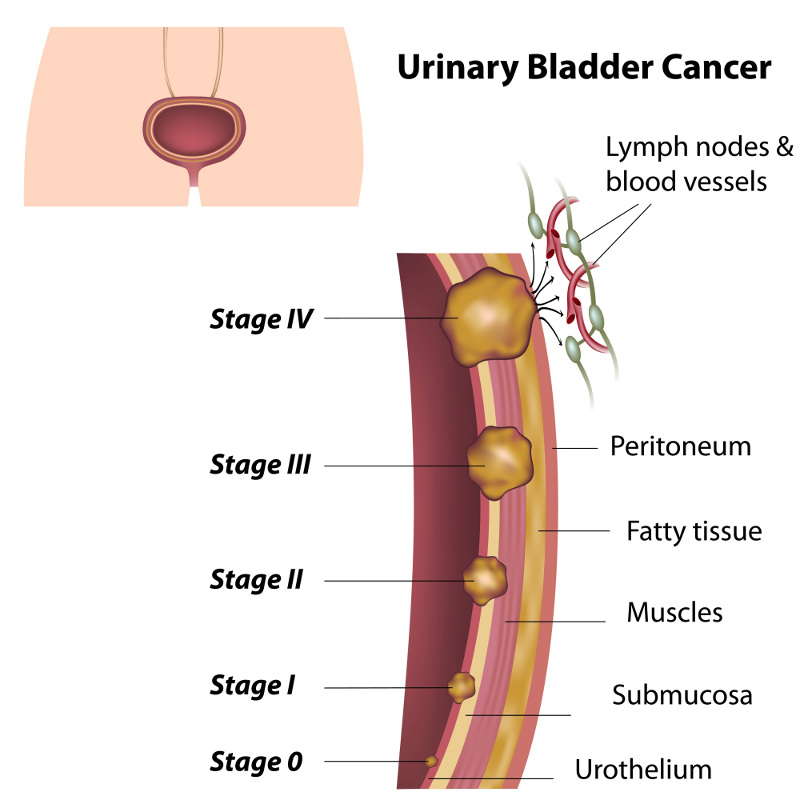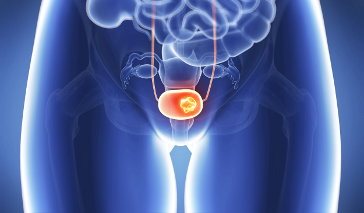Bladder cancer affects approximately 55,000 men and 18,000 women each year, most of them over 70 years old, according to the National Cancer Institute. Ninety percent of those with the disease have transitional cell cancer (TCC), also known as urothelial cancer, which begins in the transitional cells on the inner lining of the bladder. The remaining types of bladder cancer either start in other cells that line the bladder (squamous cell cancer) or in cells that secrete mucous into the bladder (adenocarcinoma).
Bladder Cancer Risks
Several factors can increase a person's risk of getting bladder cancer, including:
- Smoking
- Workplace chemicals (Those who work in the chemical, metal, textile, dye, leather and rubber industries, as well as hairdressers, printers, painters, truck drivers, and machinists are all at increased risk.)
- Prior incidence of bladder cancer
- Family history of disease
- Certain treatments for other cancers, such as some chemotherapy drugs (e.g., cyclophosphamide) or radiation therapy in the pelvis or abdomen
- Exposure to arsenic, a chemical sometimes found in drinking water
Bladder Cancer Signs and Symptoms
The main symptoms include:
- Blood in the urine
- Frequent, urgent or painful urination
- Straining while urinating
- Urge to empty the bladder with no results
The same symptoms can also be caused by other, more common problems, such as urinary tract infections. Thus, it is important to seek medical care if any of these symptoms occur.
Bladder Cancer Tests
Doctors use various methods to diagnose bladder cancer, such as:
- Physical exams, which identify changes in vital signs (such as temperature and heart rate), areas of pain or tenderness, and abnormal masses
- Urine analysis, which tests for blood, cancer cells, or other signs of disease
- Cystoscopy, in which a lighted tube (cystoscope) is used to look inside the bladder
- Biopsies, in which small pieces of tissue are removed and tested
- Imaging tests, such as a CT scan or MRI, determine the stage of the cancer
Tumor Grading
A pathologist examines the cells removed during a bladder biopsy to assess whether the tissue is cancerous and, if it is, determines its “grade.” The results help oncologists decide on appropriate treatment.
- Low-grade tumors are made up of cells that look more like normal cells. They grow slowly and are unlikely to spread to other parts of the body.
- High-grade tumors have abnormal-looking cells that grow quickly and are more likely to spread.
Bladder Cancer Stages
Bladder cancer stages are a measure of how far the disease has advanced and is also used to help doctors plan treatment.
When describing bladder cancer, doctors use the following stages:
- Stage 0: cancer cells are found only on the surface of the inner lining of the bladder
- Stage I: cancer has grown into the inner lining of the bladder, but has not yet breached the middle layer
- Stage II: cancer cells are also present in the bladder's muscle (middle) layer
- Stage III: the cancer has grown through the muscle layer to reach nearby tissues, such as the uterus, vagina or prostate
- Stage IV: the cancer has metastasized and spread beyond the bladder, such as to the wall of the pelvis or abdomen, the lymph nodes, or other parts of the body
Several tests can provide information about the cancer’s stage, including:
- Blood tests: determine how well the liver and kidneys are working
- Chest x-ray: looks for a tumor in the lungs
- Intravenous pyelogram (IVP): a special x-ray that reveals blockages or masses in the urinary tract
- CT scan: an x-ray machine hooked up to a computer
- MRI: a machine that uses a strong magnet to create and display images of the abdomen or other parts of the body
- Ultrasound: an imaging technique that uses soundwaves
Bladder Cancer Prognosis
Bladder cancer treatment will depend on the stage in which the the cancer is detected. Some options including surgery, chemotherapy, radiation, or biological therapy.
References
Bladder cancer treatment. (2013). National Cancer Institute.
Wood Jr., DP. (2011). Urothelial Tumors of the Bladder. Campbell-Walsh Urology. 10th. ed.
What you need to know about bladder cancer. (2010). National Cancer Institute. NIH Publication No. 10-1559.
Lopez-Beltran, A. (2008). Bladder cancer: clinical and pathological profile. Scand J Urol Nephrol Suppl.
Parkin, D.M. (2008). The global burden of urinary bladder cancer. Scand J Urol Nephrol Suppl.


